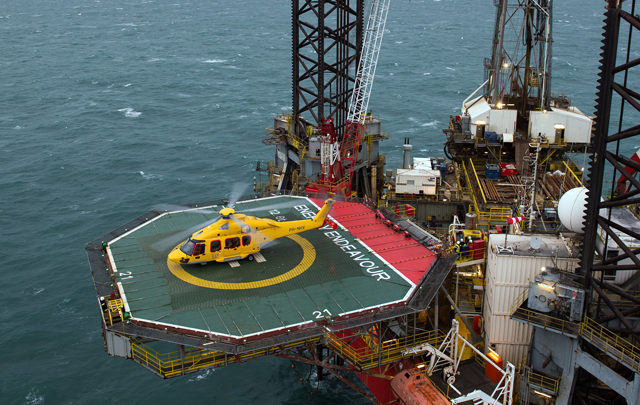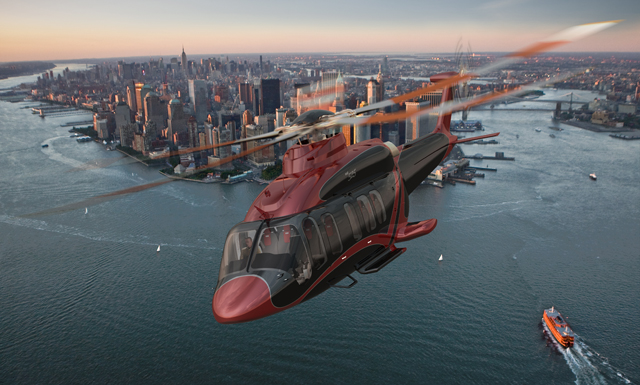At least three commercial helicopter programmes – the Airbus Helicopters EC175, AgustaWestland AW189 and Bell 525 Relentless – owe their existence to sustained oil prices over $100 per barrel. All three were launched within the last decade to capture demand from oil and gas exploration companies as they pushed drilling sites further offshore, necessitating a new subgenre of “super” medium-sized helicopters weighing 7t-9t.
The same demand that created the super-medium category helped to propel the entire commercial helicopter industry to new heights over the last five years. As fixed-wing manufacturers catering to utility and general aviation requirements struggled to overcome a 2008 recession, oil and gas companies demanded ever-increasing services and capabilities from the helicopter industry, cultivating an energised leasing industry along the way.
Oil prices have fallen by over 50% in the last six months, creating an unwelcome sense of uncertainty as all three super-medium projects near critical milestones. To make things even more awkward, there is no clear consensus on the cause of the fall in oil prices and when – or even if – they will recover to prices over $100 per barrel.
That scenario seemed most unlikely even a year ago, but is causing deep concerns among industry analysts now.
“You’ve got three primes developing new high-end midsize twins,” says Richard Aboulafia, a consultant for the Teal Group. “The overwhelming majority of those investments have already been made. I’m not so sure the market will be there for all three of them plus all the other helicopter models that are in proximate locations in the market.”

The EC175 is one of three high-end midsize twins specifically designed for the offshore market
Airbus Helicopters
The EC175 and AW189 have recently entered service and are now in the midst of steep production ramp-ups. The Bell 525, launched at Heli-Expo three years ago, is still preparing for a slightly delayed first flight as this article goes to press.
Although all three cater to other markets, their fortunes have always been tied to future demand from the oil and gas sector.
The timing of the oil price plunge seems especially awkward for the super-medium class, but the oil and gas market affects the entire industry, with more than 1,900 helicopters assigned to supporting offshore drilling rigs as of 16 February, according to the Flightglobal Ascend database. Bell Helicopter remains the largest fleet supplier to offshore oil and gas companies with 31% of the in-service fleet, followed closely by Airbus Helicopters at 29%.
Another 229 helicopters assigned to offshore oil and gas support roles are on firm order, according to Flightglobal Ascend data, with AgustaWestland accounting for the largest share with 38% and Airbus Helicopters following with 36%.
Despite the uncertain outlook, however, top helicopter industry officials with deep interests in the offshore oil and gas markets feel the outlook is not as worrisome as the economic trends appear.
Ed Washecka founded Waypoint Leasing in 2011 largely to cater to offshore oil and gas companies. Taking a page from fixed-wing lessors such as NetJets and ILFC, Waypoint is offering offshore operators vertical lift as a service, relieving the companies of the need to acquire and maintain their own dedicated fleets.
“Oil prices have been very dynamic, but demand for helicopter leases that we’ve seen hasn’t changed,” Washecka says in an interview. “I think that if anything the oil price demand causes people to think about what kind of commitments they want to make. On the one hand, you’ve got oil companies: they may not be sure if they’re going to do this project or that project. On the other hand, it makes our operator base look at leasing as giving them a lot more flexibility.”
Clouding the picture, however, is the uncertainty about when – or whether – oil prices might recover to $100 per barrel or higher.
In a 6 February earnings call, Bristow Group chief executive Jonathan Baliff – one of Waypoint’s key customers – recalls an abrupt crash in oil prices in 2009 amid a global financial crisis, when the price of a barrel of crude dropped below $40. As abruptly as prices in 2009 fell, they rose again just as steeply, creating a V-shaped recovery curve that helped companies such as Bristow, which provides fleet services to drilling rigs.

Bell's 525 Relentless was designed to reach fields further out at sea
Bell Helicopter
Six years later, Bristow is preparing for longer recovery cycle this time.
“We don't have the luxury in many ways of hoping that it is V-shaped,” Baliff says. “We have to plan for something that is U-shaped that has some cost structure adjustments.”
In a U-shaped recovery, the prices stabilize at the lowest level for a sustained period before a very rapid recovery. That represents the model that Bristow is using to manage its long-term fleet plans during this downward cycle in oil prices.
“Bristow leadership has seen a lot of upturns and downturns. We come from all parts of the energy services value chain these past 20 to 30 years,” Baliff says. “We believe the snapback will be as particularly dramatic upwards as it was downwards, and we are managing that eventual renewal because it takes about three years to actually build a helicopter.”
For helicopter manufacturers, the impact of falling oil prices is more nuanced. In customer segments that are distinct from the oil and gas industry, lower oil prices can help generate cash to buy more or newer helicopters by reducing operation costs. So far, the manufacturers have not made any bold moves, such as publicly delaying a programme or cutting production.
United Technologies subsidiary Sikorsky, for example, still believes the impact of oil and gas prices is marginal on programmes such as the S-76D and S-92.
“There is a little bit of pressure there; some of the exploration companies are scaling back,” says Greg Hayes, chief executive of United Technologies. “More than 80% of the use of the helicopters for offshore oil is for current production – it's not for exploration. So, you're talking on the margin: yes, there may be a few aircraft that will be little bit more difficult to sell.”
Source: FlightGlobal.com



















